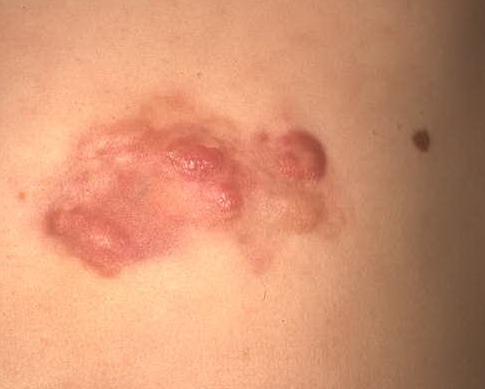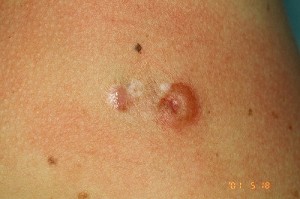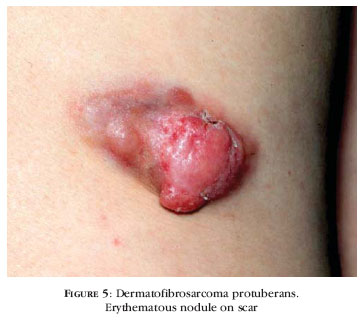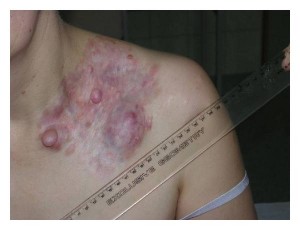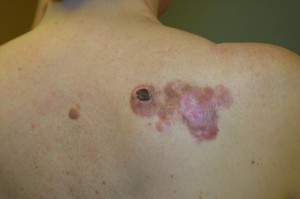Dermatofibrosarcoma Protuberans – Pictures, Symptoms, Treatment
What is Dermatofibrosarcoma Protuberans?
Dermatofibrosarcoma Protuberans is a rare soft tissue growth that is slow-growing, not often metastasize (less than 4% of total number of cases), in some cases of spreading, the lungs are the most common direction. It frequently recurs or remains. It can enter both the muscle and bone. It happens in all ages, but most commonly among adults, from early on up to middle adulthood. The average age of onset is 40 years. It is one of the rarest among all skin cancers; approximately less than one per 100,00 cases are recorded every year. It is the most common cutaneous sarcoma.
Symptoms of Dermatofibrosarcoma Protuberans
Tumor
Tumors usually start as slow-growing. The progression is also delayed. It usually starts in a small papule or small patch that appears anywhere in the body, but frequently on the trunk. Tumors are usually smooth and even, sclerotic and yellowish in color. The tumor grows in a particular direction, extends upward and downward, following the path of the least resistance. It later develops in a larger nodules.
Variants:
- Bednar Tumor
A pigmented form of DFSP occurring predominantly in African descendants and representing less than 5% of all DFSP. It has a lower recurrence rate.
- Myxoid DFSP
Characterized by the interstitial accumulation of hyaluronic acid ground substance, rendering the usual storiform pattern less pronounced and a nonpatterned array of vessel more apparent.
- Giant cell fibroblastoma
A rare mesenchymal tumor occurs predominantly in the first decade of life, showing an unidue combination of spindle cell patterns, myxoid aread, pleomorphic and multinucleated giant cells, and distinctive sinusoid-like spaces. Local recurrence is common but metastasize is not
Stages:
Stage 1
Primary tumor appears as well as localized disease
Stage 2
Metastasize occurs in the Lymph nodes
Stage 3
Distal Metastasize happens
Diagnosis of Dermatofibrosarcoma Protuberans
Histologic Findings
The characteristic of Dermafibrosarcoma protuberans under microscopy is a widely-spreading dermis and subcutenous tissues. The tumor can get through the space between the subcutaneous tissue. Aspiration using fine needle smears are commonly hypercellular and stroma poor. The mitotic activity is usually low; inflammatory infitrates, foamy histiocytes, multinucleated cells and hemosiderin deposits are not common. The overlying epidermis is generally thin or ulcerated.
According to Layfield, the following results are observed in Dermafibrosarcoma:
a. Smears of moderate cellularity containing single cells and cells entrapped within tissue fragments, stromal fragments with a fibrillar character
b. Plump oval to spindle isolated cells with bland nuclear features and a fine chromatine pattern
c. A moderate amount of cytoplasm with a pale, granular appearance
d. Rare mitotic figures
Differential Diagnosis
The following should be made different with Dermafibrosarcoma protuberans.
a. Low grade spindle sarcoma
b. Benign fibrous histiocytoma
c. Desmoids
d. Low grade malignant peripheral nerve sheath tumor
Other diagnostic procedures include:
Chest Xray
Since the lungs are the common site of metastasize, screening for pulmonary spread out is very important.
Computed Tomography Scanning
To detect if there is bone or muscle involvement.
Magnetic resonance Imaging
To define the periphery and the extent of the tumor.
Fluorodeoxyglucose (FDG) Scanning
To monitor the degree of metastasize.
Treatment of Dermatofibrosarcoma Protuberans
a. Surgery
Surgical removal of the tumor is the primary and best treatment for Dermatofibrosarcoma protuberans. It is called Mohs Surgery; it takes away not only the tumor but the pathological cells also. The rate of Mohs surgery is highly successful.
b. Chemotherapy
Use of oral drugs like Imatinib produce positive results to reduce the tumor in patients with Dermatofibrosarcoma protuberans
c. Radiation Therapy
Radiation Therapy is more present compared to the past. It is recommended to prevent deficits in the functional or appearance of a person. It also lessens the risk of recurrence; its risk of complication is also low.
Prognosis
The prognosis for Dermatofibrosarcoma protuberans has a higher chance of survival if detected early. Malignancy is rare and the incident of Metastasis is uncommon. But in some cases, the tumor recurs. It has an average of approximately 50% chance of coming back. Tumors can result in death if they become malignant.
ICD9 code
ICD-9 Codes
173.90 – Unspecified malignant neoplasm of skin, site unspecified
Dermatofibrosarcoma Protuberans Pictures
A starting tumor at the trunk
A single erythematous tumor with small surrounding papules
Diffused Dermatofibrosarcoma protuberans at the chest area
Necrotic Dermatofibrosarcoma protuberans showing a dark spot on the back
